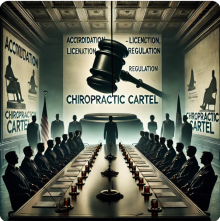The Chiropractic Cartel: A Look Back at Bias in Accreditation and its Imact on Today's Profession

In the chiropractic profession, battles over accreditation and philosophical dominance have been ongoing for decades. One of the most significant examples of this struggle came in 2003 when Life University filed a lawsuit against the Council on Chiropractic Education (CCE), accusing the accrediting body of favoritism and procedural misconduct. Although this lawsuit is now more than 20 years old, the issues it raised are as relevant today as they were back then, framing the ongoing debate over what has come to be called the "Chiropractic Cartel."
Revisiting the 2003 lawsuit
In 2003, Life University, once the largest chiropractic school in the world, took legal action against the CCE. The university alleged that the CCE had manipulated accreditation standards to favor a more "liberal" chiropractic philosophy, aligned closely with the American Chiropractic Association (ACA). This philosophy advocates for a broader scope of practice, including the use of medical procedures and positioning chiropractors as primary care physicians with a wider array of treatment methods.
On the other side of the spectrum, Life University supported a more "conservative" chiropractic philosophy, which emphasizes the traditional analysis and adjustment of spinal subluxations without the inclusion of ancillary medical treatments. Life argued that the CCE, by enforcing standards that favored the liberal approach, was effectively marginalizing schools and practitioners who adhered to this conservative philosophy.
The lawsuit detailed how the CCE allegedly overstepped its role as an accrediting body by not remaining neutral in the philosophical divide within chiropractic. Life University accused the CCE of violating its own bylaws and engaging in biased practices that led to the wrongful denial of Life’s accreditation, causing significant financial and reputational damage to the university.
The Chiropractic Cartel - History & Current Implications
The term "Chiropractic Cartel" was notably highlighted by Dr. Lawrence J. DeNardis, a member of the United States Department of Education's National Advisory Committee on Institutional Quality and Integrity (NACIQI), during a 2006 hearing on the CCE’s petition for renewal of recognition. Dr. DeNardis remarked:
"Madam Chair, we've heard charges and countercharges from I trust a wide, fairly wide spectrum of the chiropractic profession. At least that's the way it seems to me. Battles over turf, battles over philosophy, maybe battles over personal ambition, but divisions of every kind. And some of this, maybe most of it, is a consequence of, at least as I see it, a monopoly control of a profession which has led to the establishment of a virtual cartel, not unusual. There are several other professions that we deal with that have a virtual cartel control of the profession. We can't change that, but we can consider measures that will try to send a message to the prevailing control group that they should try to be more inclusive rather than less inclusive and I suggest that we try to figure out what is within our range of alternatives to do that. Because I believe if we simply hear it, discuss it, anguish over it, and then give them five years of recognition, that we haven't been the impetus for any corrective action for the profession and I worry about the profession."
In an article by Donald D. Harrison, DC, PhD, MSE in the American Journal of Clinical Chiropractic on February 13, 2011 titled: FCLB’s New ‘Model Practice Act’: A Slippery Slope, Harrison even refers to a Cartel flow chart in an attempt to demonstrate how money flows within a small group of tightly connected organizations stating:
"The “Chiro Cartel” of our profession can be studied in Figure 1 as I personally envision it to exist. Notice that nearly all money funding the Cartel comes from field DCs and students. In my opinion, the resultant collusion is to advance the profession toward the model of allopathic medicine"
Adding to this sentiment, in 2013, Attorney Anne Neal, JD, also a member of NACIQI, drew an even starker comparison when she stated:
"Now it may get to the broader issue which was raised earlier that in a monopoly situation, the climate of fear that we've been hearing about, that probably happens because frankly when you're accepting these standards in a monopoly situation, that's about as voluntary as accepting an offer from Tony Soprano, so I think that's the issue we really are dealing with here. But I'm very concerned that we've got to play fair with everyone, and I'm not sure we're playing fair or the Department is playing fair."
These statements underscore a growing concern that the chiropractic profession is dominated by a small, powerful group that controls its direction and policies. The 2003 lawsuit against the CCE was an early warning of this dynamic, illustrating how the accrediting body, through its actions, was shaping the future of chiropractic education in a way that favored certain philosophies over others.
Today, the influence of the Chiropractic Cartel remains evident and has become more apparent as its actions have become more brazen and are brought more out into the open. The same entities that were at the center of the controversy in 2003 continue to exert considerable control over chiropractic education, licensing, and practice standards.
The CCE controls accreditation of the schools through a monopoly enshrined in state statutes. the National Board of Chiropractic Examiners (NBCE) not only controls testing through a monopoly enshrined in state statutes but their exams are used as a defacto "licensing" exam and are used by the CCE to track licensing outcomes even though they are not a direct measure of whether or not someone got licensed or not.
So the CCE and NBCE are engaged in "product tying" which occurs when one private corporation requires customers to purchase a secondary product or service in order to obtain a primary product or service. In this case the "products" are accreditation, a chiropractic education and a license to practice a profession. This practice raises legal concerns, particularly under antitrust laws, if it restricts competition or forces consumers to buy products or services they may not want.
Then there is the Federation of Chiropractic Licensing Boards (FCLB) which falsely claims to be "an association of government agencies empowered to regulate the chiropractic profession". In fact the FCLB is just a private corporation made up of self selected individuals. Individuals who also tend to serve on state regulatory boards as well as the NBCE and various trade organizations and bounce back and forth between them. This was highlighted in the recent Vanterpool lawsuit against the FCLB. The FCLB uses state tax dollars and the nearly million dollars a year it gets from the NBCE to dictate policy within the chiropractic profession. The FCLB already controls a significant portion of post graduate education and is getting ready to take over credentialing of post graduate certification and specialty programs.
Then comes the Chiropractic Summit Group which is a secret "Fight Club" type organization overseen by the Michigan Association of Chiropractors (MAC) with "Summit Partners" who pay yearly dues to have a "seat at the table".
While according to the Executive Director Lisa Love-Smith, the Chiropractic Summit was created in September 2007 in recognition of the profession's desire for unity the Summit Group is really just the next iteration of the National Chiropractic Leadership Forum (NCLF) that formed in 2000 and then fell apart due to disagreements surrounding the introduction of chiropractic into the VA. Those that saw the real intentions of the NCLF left and those complicit in its efforts remained and reconstituted it as the Summit.
Nevertheless, Love Smith claims:
"The first Summit meeting, held in Washington, D.C., was comprised of 13 organizations; the Summit currently has some 30 partner organizations, representing leadership from education, research, regulatory bodies, political action, practice management, chiropractic media and national associations."
The current membership list of these 30 "Summit Partners" is a closely guarded secret and while Love Smith, who is also the Executive Director for MAC, refuses to disclose the list, it is known to include at least the FCLB, the International Chiropractors Association (ICA), ChiroCongress, Foundation for Chiropractic Progress and some chiropractic schools.
In 2013 during the height of the CCE and USDE debacle, the Summit Group consisted of the following organizations:
- Council on Chiropractic Education
- International Chiropractors Association
- Student International Chiropractors Association
- American Chiropractic Association
- Student American Chiropractic Association:
- World Federation of Chiropractic
- Association of Chiropractic Colleges
- Foundation for the Advancement of Chiropractic
- Tenets & Science (ICA)
- National Board of Chiropractic Examiners
- Federation of Chiropractic Licensing Boards
- Foundation for Chiropractic Progress
- National Association of Chiropractic Attorneys
- American Black Chiropractic Association
- Student American Black Chiropractic Association
- Canadian Chiropractic Association
- Congress of Chiropractic State Associations
- Council on Chiropractic Guidelines & Practice
- Parameters
- Life University
- Life Chiropractic College - Wiest
- Logan Chiropractic College
- Texas Chiropractic College
- New York Chiropractic: College
- Northwestern Health Sciences University
- Palmer College of Chiropractic
- Cleveland Chiropractic College
- Parker College of Chiropractic
- Southern California University of Health Sciences
- University of Western States
- National Chiropractic Mutual Insurance Company (NCMIC)
- ChiroSecure Malpractice
- Standard Process.
- Breakthrough Coaching
- Chiropractic Economics Magazine
- Chirotouch
- David Singer Enterprises
- Dynamic Chiropractic
- Foot Levelers
- The American Chiropractor
- The Masters Circle
- Future Health Software
This consolidation of power to several private corporations (CCE, NBCE and FCLB) giving them complete control over the educational, licensing, regulatory and practice aspects of the profession and then leveraging that power with a larger group of trade groups and private corporations not only limits the diversity of thought within the profession, forcing practitioners to conform to a narrowly defined model of chiropractic care but it also raises several legal and ethical issues.
For chiropractors who align with the conservative philosophy, the ongoing influence of the chiropractic cartel presents significant challenges. They may find themselves marginalized, with fewer opportunities for education, licensure, and professional growth. This has far-reaching implications for the profession as a whole, as it restricts patient access to a variety of chiropractic approaches.
A Historical Lens on Current Struggles
Looking back at the 2003 lawsuit offers valuable insights into the current battles within chiropractic. The same issues that were at play then—bias in accreditation, the suppression of alternative philosophies, and the consolidation of power—are still relevant today. The legacy of that lawsuit, combined with the insights from the 2006 and 2013 hearings, serves as a reminder of the importance of vigilance and advocacy in maintaining a fair and diverse chiropractic profession.
The chiropractic community must continue to fight for transparency and fairness in all aspects of the profession, from education to licensure to practice standards. By learning from the past and applying those lessons to the present, chiropractors can work to dismantle the chiropractic cartel and ensure that the profession remains open to all philosophies and approaches.
Conclusion
The 2003 lawsuit between Life University and the CCE was a pivotal moment in chiropractic history, highlighting the deep divisions and power struggles within the profession. The comments made by Dr. DeNardis in 2006 and Anne Neal in 2013 further underscore the ongoing challenges faced by the chiropractic community. As the profession continues to confront these issues, it is crucial to remember the lessons of the past. Only by fostering an environment of transparency, fairness, and diversity can the profession truly serve the needs of its practitioners and patients.
Today, the battle against the Chiropractic Cartel is ongoing, and the stakes are higher than ever. By standing together and demanding accountability, chiropractors can protect the integrity of their profession and ensure that all voices within chiropractic are heard.

Blogs
- The Chiropractic Cartel: A Look Back at Bias in Accreditation and its Imact on Today's Profession
- Inside Montana's Chiropractic Monopoly: ACA & MCA's Brazen Board Takeover
- Concerns Grow About Control of the NY State Chiropractic Board by the ACA - Use of X-ray in NY Under Threat
- Reproductive Health Information and Chiropractic Care: Navigating New Privacy Regulations
- Navigating Substance Use Disorder (SUD) Consent: What Chiropractors Need to Know













